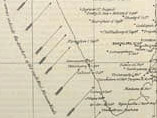 About the collection
About the collection
Disease: Cholera
The Medical History of British India collection shows the effects of cholera in India from 1817 to the 1900s.
Cholera was not a well-known disease before the 19th century, but this was to change after the particularly virulent epidemic of 1817-1821 shook the medical establishment of the East India Company. Due to the immense fatalities of the disease and its terrifying symptoms, by the 1830s, cholera was recognised widely in Europe as a fatal disease originating in India.
Cholera in the army
Cholera was an important factor in increasing the mortality of European soldiers, a cause of much alarm within the colonial establishment. The Third Anglo-Maratha War coincided with the 1817-1821 cholera epidemic and the death of troops on the march during the campaign contributed to a colonial perception of cholera as a deadly foe of the army. Such associations were further underlined by the deaths of white soldiers and generals during the sieges of 1857 and the campaign launched to relieve them. Pioneering historical accounts of cholera epidemics have pointed to the colonial military establishment's suspicion towards the camp followers – who came from the lowest echelons in Indian society and ranked the lowest within the military hierarchy – as the source of cholera within the army.
The Medical History of British India collection provides an opportunity for those seeking reconstruct life within the cholera camps that were constructed to prevent the introduction and spread of cholera within the army.
State intervention
While cholera took the greatest toll in industrial and urban slums in the West, in India cholera was the disease of the rural poor. Although cholera followed its own epidemic cycle, its fatality was greatly increased when an epidemic coincided with a famine. Both indigenous as well as western medicine failed to provide a cure for cholera throughout the 19th century, prompting the authorities to concentrate on the prevention of the disease rather than its treatment. Hence no efforts were made to impose western medical treatment or hospitalisation on the indigenous population.
The closest that the colonial state came to intervention in Indian civil life was in its attempts to investigate the relationship between Hindu pilgrimages and cholera, and subsequently, in regulating the sanitation of sites of pilgrimage.
Cholera mortality declined in the early 20th century, though no significant state intervention had taken place in the realm of sanitation, nor had there been an improvement in the material conditions of the masses.



